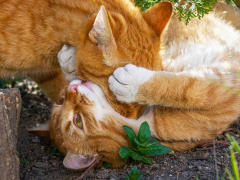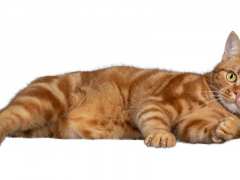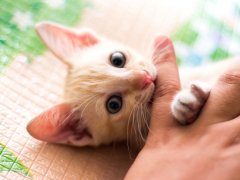
Are you frustrated, losing sleep, and thinking of giving your cat away because he or she is peeing outside of the litter box?
You are not alone! House soiling outside the litter box is one of the most widespread behaviour problems cats exhibit, yet it is one of the last problems cat owners seek professional help for.
Instead, cat owners may not recognise that there are several solutions available and may not realize that cat behaviourists even exist.
In this article, we’ll demystify the reasons for inappropriate elimination, explain how to meet your cat’s individual needs, discuss ways to prevent house soiling, and help you decide when to seek specialist support.
We will also empower you to be a responsible, alert cat parent, reduce the impact on your household, and improve your cat’s quality of life!
Why Is My Cat Peeing Everywhere Suddenly?
All cats soiling outside of the litter box should undergo a medical (thorough physical examination and diagnostic testing) and behavioural evaluation.
There could be several reasons your cat is peeing everywhere. Causes include medical problems, aversion to the litter and litterbox, marking behaviours, poor house training, and social and environmental stressors. Let’s go into more detail.
Explanation of the Causes of Peeing Outside of the Litter Box
Cats are clean and fastidious creatures, particularly about their toileting habits and unlikely to soil outside the litter box for no reason.
A few of the explanations for your cat peeing outside of the litter box include:
1. Medical Reasons
Perhaps the most common medical cause of cats peeing outside the litter box is feline lower urinary tract disease or FLUTD.
FLUTD is a term used to define a group of illnesses that affects the lower urinary tract in cats: feline idiopathic cystitis (FIC) is the most common reason for house soiling causes in cats, producing increased rate of urination, difficulty, and pain when urinating.
This inflammatory condition can vary in severity and is intensified by stress and other problems while urethral obstruction (from crystals or stones) can be life-threatening and requires immediate medical attention (male cats are more prone to blockages than female cats).
Here are some other medical conditions that may lead to peeing outside of the litter box:
- Diabetes mellitus
- Arthritis pain
- Cognitive dysfunction such as dementia
- Dental disease
- Post-declaw pain
- Blindness from retinal detachment, diabetes, or old age
- Chronic kidney failure
2. Environmental Stressors
Cats are individuals and need access to environmental resources without being confronted by other cats. Key resources such as food, water, scratching posts, resting areas, play, and toileting sites should be available in multiple separate locations to avoid stress and competition in multi-cat households.
Even in single-cat homes, having an appropriate number of litter boxes, food, and water in separate locations is of great benefit. Outdoor cats should have adequate indoor trays to eliminate frustration and stress from unpredictability.
Cats are territorial and their sense of smell is a primary means by which cats evaluate their surroundings. Introductions of odours, materials (i.e. chemicals, medications, detergents) or new places (home relocation) will disrupt the cat’s sensory perception of its environment causing anxiety associated problems behaviour.
3. Social Conflicts
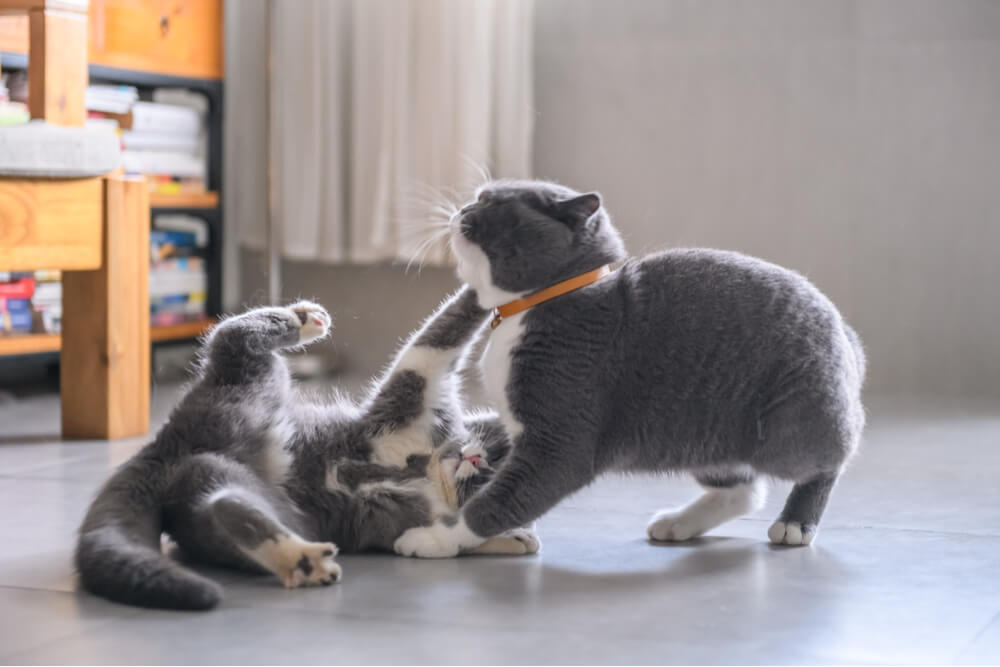
Conflict between cats may increase stress and tension around the litter box, leading to inappropriate urination.
Cats may urinate outside of the litter box due to social conflicts and fights. These conflicts may result from various issues. Multi-story properties with narrow stairways can easily create territorial struggles when cats housed together. An assertive cat may prevent a nervous cat from getting to the litter tray.
4. Cat-Person Distress
The significance of owners as potential stressors is often overlooked since most cat-human relationships are positive. Unpredictable and intrusive owners who over fuss may create stress for the cat while lack of stroking may create fear.
Any changes within the household dynamics, such as the owner’s absence or a visiting family member can cause anxiety and distress. Giving your cat a sense of control and security is key.
5. Litter Box Aversion and Inappropriate Site Preferences
An aversion to the litter box is common and can lead to house soiling. Aversion could be to the box, the litter, location of the box, or all combined. A cat with an aversion to their litter box will usually eliminate on a variety of surfaces (bed, carpet, clothing, floors, bathtub, etc). Your cat may prefer to eliminate in another spot or on a specific surface like clothing or carpets. Cats that choose alternate locations often have an aversion to the litter box location.
6. Finally, Your Cat Might Be Exhibiting Territorial Spraying Behavior
Cats freely eliminate wastes in 3 ways: squat urination (peeing), defecation, and urine spraying.
Urine eliminated by squatting makes a circular puddle on the substrate. The average cat pees large volumes of urine 2 times per day and defecates (solid waste) 1 per day (and up to 3-4 times in outdoor cats).
When spraying, your cat typically stands upright on all 4 limbs and holds its tail vertically, your cat will not dig before it sprays or covers the affected area afterward. When spraying, your cat generally vacates small volumes of urine onto vertical surfaces.
To assist your veterinarian, differentiate between spraying and squat urination, record a video of your cat “doing their business” and keep a diary/journal of the presented behavior.
How To Prevent or Minimize Your Cat Peeing Outside the Litter Box?
1. Ensure Your Cat Is Neutered!
Help your kitten be successful with litter box training from day one.
2. Use the Right Number of Litter Trays.
The ideal number of trays in an indoor environment is 1 tray per cat, plus 1 placed in different locations. Trays can be covered with hoods or open shallow containing a commercial litter with which the cat is familiar (recommended litter materials; recycled paper, corn-based, clumping variety, some cats can be averse to polythene liners and litter deodorants).
3. Make Sure Your Cat’s Litter Boxes Are the Right Size.
Trays should be at least 1.5x the length of your cat’s body (most litter boxes are too small; storage boxes and small dog litter pans make excellent boxes). Litter depth preference of most cats is about 1.5 inches.
Litter locations should be discreet and away from busy thoroughfares, the tray should be cleaned daily and the litter should reflect the cat’s natural desire to use a sand-like substance (Do NOT change your cat’s litter type). Soiled litter must be removed daily while litter trays should be washed and disinfected once weekly or fortnightly. Do NOT move the litter trays as it may confuse your cat and they may try to eliminate in the previous spot.
4. Boredom Stresses Cats. Daily Play-Based Interaction With Their Owner Is Vital.
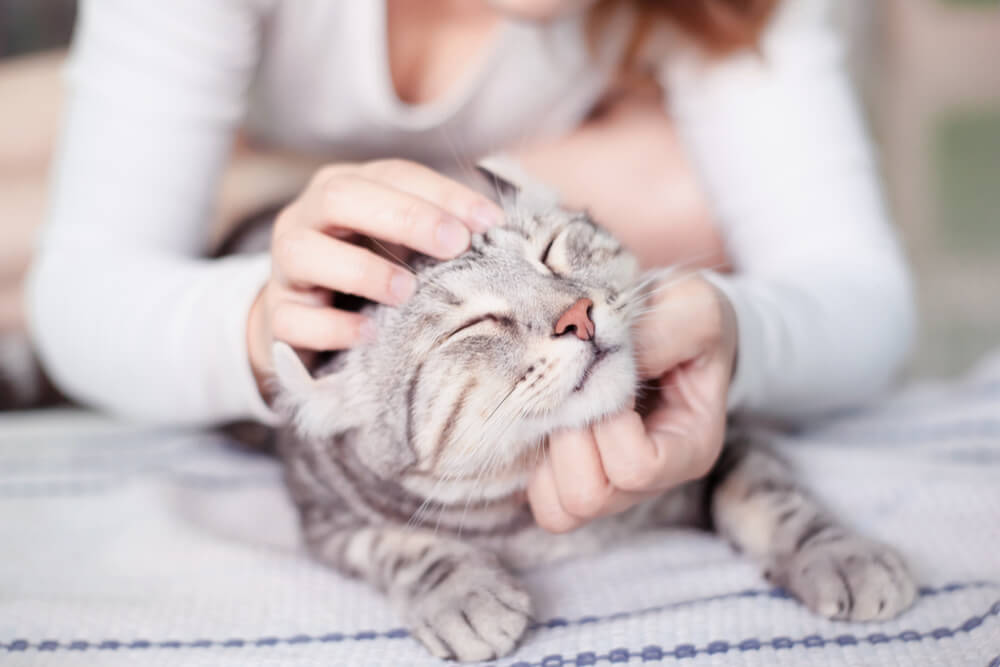
Relieving boredom and stress can help to minimize inappropriate urination.
Consistent, positive, and predictable human cat-social interaction allows the cat to both initiate and stop interactive behavior.
How To Manage and Treat Litter Box Problems?
Resolving house soiling difficulties may necessitate making easy changes to several features of your cat’s home environment and care.
This may also include medical treatments, diet alterations, and behaviour modifications consisting of:
- Medication if/as prescribed by your veterinarian (i.e. anti-anxiety meds).
- Joint supplementation; beneficial for cats with chronic joint problems like arthritis.
- Use of positive reinforcement (i.e. treats) when your cat uses the litterbox.
- Keep fighting cats separated unless supervised and utilise reintroduction procedures in cases of inter-cat conflict.
- Adequate vertical space; tree towers for resting and hiding.
- Use of Feliway (synthetic pheromones); spray on affected areas and plug-in a Feliway diffuser to your cat’s most frequented room.
- Play-based interaction with the owner and use of food-dispensing toys like puzzles to reduce boredom, stress, and obesity (all linked to FIC).
- Minimisation of external stimuli exposure by blocking outside view (static film, blinds, translucent window coverings).
- Daily mental and physical stimulation (environmental enrichment); leash walking, training, and play with novelty toys.
- Litter attractant add-on (natural mix of herbs and plant extracts).
- Predictable daily routine and feeding times.
- Behaviour modification in conjunction with litter-tray management.
Also Read: The 10 Best Cat Slow Feeders & Puzzle Feeders
Most inappropriate elimination cases can be treated successfully once they have been accurately identified and dealt with. Early intervention is key and represents the best chance to redirect your feline companion back into the litter box!
Tried everything and your cat is still experiencing elimination problems? Do not give up! Please seek a referral to a Cat Behaviourist or head to IAABC to Find an Animal Behaviour Consultant in your area.
-
Caney, S. (2016, November 15). Feline idiopathic cystitis management: role of the nurse and technician. (I. C. Care, Compiler) UK: Feline Focus. Retrieved April 26, 2020
-
Care, I. C. (2018, August 13). Soiling indoors. (I. C. Care, Producer) Retrieved April 24, 2020, from International Cat Care: https://icatcare.org/advice/soiling-indoors/
-
Foote, D. S. (2018, May 01). Litter Box Misses – When Your Cat Goes Right Next to the Box. (CattleDog Publishing ) Retrieved April 27, 2020, from Dr. Sophia Yin: https://cattledogpublishing.com/blog/litter-box-misses-when-your-cat-goes-right-next-to-the-box/
-
Hazel Carney, T. S. (2014). AAFP and ISFM Guidelines for Diagnosing and Solving House-Soiling Behavior in Cats. (A. A. Practitioners, Ed.) Journal of Feline Medicine and Surgery, 16, 579-598. Retrieved April 26, 2020
-
Horwitz, D. (2017). Stress and anxiety in cats: Effect on litter box use. St Louis, MO, USA. Retrieved April 28, 2020
-
Karen Overall, I. R.-D.-M. (2004, December 01). Feline Behaviour Guidelines. (A. A. Practitioners, Compiler) USA. Retrieved April 25, 2020
-
Medicine, C. U. (2015, January). Feline Behavior Problems: House Soiling. Retrieved April 23, 2020, from Cornell Feline Health Center: https://www.vet.cornell.edu/departments-centers-and-institutes/cornell-feline-health-center/health-information/feline-health-topics/feline-behavior-problems-house-soiling
-
Sparkes, I. a. (2016, November 01). Feline Stress and Health Managing Negative Emotions to Improve Feline Health and Wellbeing. UK: International Society of Feline Medicine. Retrieved April 25, 2020
-
Xavier Manteca, M. A. (2015, February). House soiling in cats. (F. Focus, Compiler) UK. Retrieved April 28, 2020

